|
 |
 |
Sigh of relief as October ends and jobs say "soft landing"
Econoday Simply Economics 11/3/00
By Evelina M. Tainer, Chief Economist |
October blues...yesterday's news?
Stock prices were generally higher this past week as the calendar pages turned from October to November. The month of October is generally associated with market crashes - even though many of the worst declines have come in other months as well. Market players tend to be somewhat superstitious - and it doesn't help when the financial media pounds away at October's dark history! As the election approaches market players may grow even more calm - and more positive. Many analysts do expect some upward movement through the end of the year.
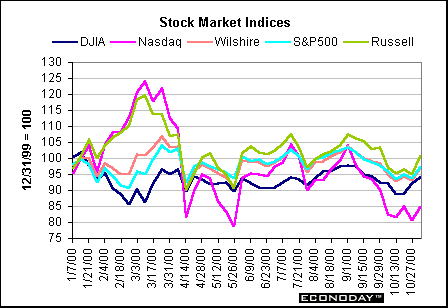
Treasury prices drift down and yields up
Given that the equity market was running in a higher gear this past week, those investors who had fled to the Treasury market as a safe haven reversed course. As a result, there was a tendency towards higher yields and lower prices in the Treasury market this past week. Economic fundamentals were generally favorable, because the economy does appear to be growing at a slower rate. On Friday, bond investors focused on the higher wage component in the employment data and took prices down further. Next week will be a tough week for the bond market given that the economic calendar is meager and Friday is a government holiday.
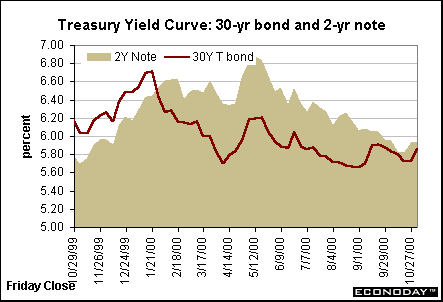
Markets
at a Glance
|
| Treasury Securities |
12/31/99 |
2000
High |
2000
Low |
27-Oct |
3-Nov |
Week %
Change |
| 30-year Bond |
6.48% |
6.75% |
5.66% |
5.74% |
5.86% |
0.12% |
| 10-year Note |
6.43% |
6.77% |
5.68% |
5.71% |
5.82% |
0.11% |
| 5-year Note |
6.34% |
6.81% |
5.90% |
5.78% |
5.85% |
0.07% |
| 2-year Note |
6.24% |
6.90% |
6.07% |
5.93% |
5.93% |
0.00% |
| |
|
|
|
|
|
|
| Fed Funds Rate Target |
5.50% |
6.50% |
5.50% |
6.50% |
6.50% |
0.00% |
| |
|
|
|
|
|
|
| Stock
Prices |
|
|
|
|
|
|
| DJIA |
11497 |
11723 |
9811 |
10591 |
10818 |
2.1% |
| S&P 500 |
1469 |
1524 |
1348 |
1380 |
1427 |
3.4% |
| NASDAQ Composite |
4069 |
5049 |
3164 |
3278 |
3452 |
5.3% |
| Russell 2000 |
505 |
606 |
457 |
480 |
508 |
5.8% |
| Wilshire 5000 |
13813 |
14751 |
12475 |
12860 |
13383 |
4.1% |
| |
|
|
|
|
|
|
| Exchange
Rates |
|
|
|
|
|
|
| $/Euro |
1.0008 |
0.8269 |
1.0336 |
0.8403 |
0.8669 |
3.2% |
| Yen/$ |
102.40 |
111.35 |
101.45 |
108.69 |
107.40 |
-1.2% |
| |
|
|
|
|
|
|
| Commodity
Prices |
|
|
|
|
|
|
| Crude Oil ($/barrel) |
$25.60 |
$37.20 |
$21.20 |
$32.80 |
$32.60 |
-0.6% |
| Gold ($/ounce) |
$289.60 |
$326.00 |
$273.90 |
$266.00 |
$266.30 |
0.1% |
| |
|
|
|
|
|
|
Employment moderation implies soft landing
Nonfarm payroll employment rose 137,000 in October after a downward revised gain of 195,000 in September. Between January and September (green bars in the chart), nonfarm payrolls were affected by a variety of special factors -- the temporary employment of Census workers and large labor walkouts. But with October, a month clear of special factors. And the result, the pace of monthly activity suggests that labor demand may be softening.

The civilian unemployment rate remained unchanged at 3.9 percent in October as both the labor force and household employment grew at roughly the same pace. Market players are beginning to follow a series cited by Alan Greenspan, the pool of available workers. This series posted a modest gain in October, but followed two sharp monthly declines. All in all, it continues to show a shrinking labor pool. This is likely to worry Fed officials, but they might be at least partly reassured by the slower pace of growth in nonfarm payrolls.
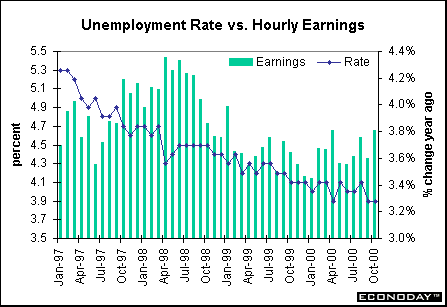
Average hourly earnings rose 0.4 percent in October, faster than last month, but in line with the past few months. This brought the year-over-year gain back to 3.8 percent. Again, this was a slight hike from September, but remains in line with the range of the past six months. These figures are not worrisome by themselves, but the Fed's Beige Book reported earlier in the week indicated that wage pressures are percolating in some of the Federal Reserve districts.
The bottom-line on employment? The employment situation suggests that economic activity is indeed on a more moderate growth path. This should assuage the fears of equity and bond investors that the economy is growing so rapidly that the Fed would need to tighten in months ahead. While the economic data appear to be moderating, wage gains are not low enough that the Fed is likely to remove their inflation risk bias at the next FOMC meeting on November 15.
Productivity remains in high gear
Nonfarm productivity grew at a 3.8 percent rate in the third quarter after increasing at a 6.1 percent rate in the second quarter. Productivity growth was higher than expected after last week's GDP slowdown for the same period. At 5 percent, the year-over-year rise in nonfarm productivity is down only a tad from the previous quarter's 5.3 percent yearly gain. The chart below shows how productivity gains have been generally accelerating in the past several quarters, rather than moderating, like everyone had initially predicted.
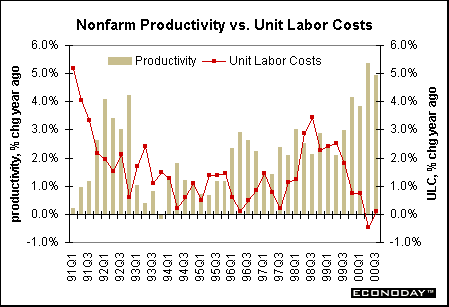
Unit labor costs increased at a 2.5 percent rate in the third quarter after declining at a 0.2 percent rate in the April to June period. This is less friendly news for markets and the economy, but the picture is less cloudy when one looks at the year-over-year rise. Indeed, unit labor costs were up a meager 0.1 percent from the third quarter 1999. The chart above depicts a generally favorable trend for unit labor costs over the past couple of years.
The bottom-line on productivity? The productivity data were on the whole favorable from an economic perspective despite the uptick in unit labor costs. Trends in productivity remain on the upswing even at this mature phase of the economic business cycle. Clearly, nonfarm business continues to benefit from technological changes. A few years ago, Fed chairman Alan Greenspan warned that the growth in productivity would soon stop accelerating. Well, that hasn't happened in the past couple of years. On the contrary, growth has accelerated. As long as productivity growth continues at this healthy pace, it will keep wage inflation in check.
Factory orders moderate
Factory orders rose in August and September, but the July plunge insured that total factory orders would be down for the quarter as a whole. Nondefense capital goods orders were down for the quarter as well - reflecting the volatile aircraft sector. As usual, orders for information technology equipment did rise, but notice that the pace is quite a bit slower than the previous four quarters. This points to some moderation in industrial production in coming months.
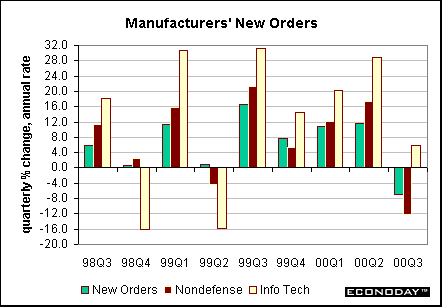
Odds & Ends
Personal income grew faster than expected in September, but the gains came from a surge in farm subsidy payments. Increases in wages and salaries were in line with recent trends. The farm subsidy spurt did cause a boost in year-over-year growth in personal income, as indicated in the chart below. Consumer spending picked up a tad from the past few months. This allowed the personal savings rate to "increase" to -0.1 percent from -0.4 percent last month. What can one say? Savings remain meager by historical standards.
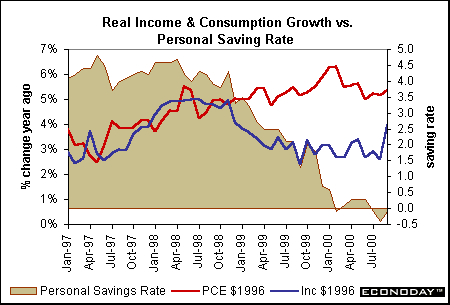
Sales of new single family homes surged 9.2 percent in September, more than reversing the previous month's drop. This put sales 11.6 percent above year ago levels. Existing home sales weren't as strong in September. Nevertheless, new and existing home sales were a bit stronger in the second and third quarters of the year, relative to the first quarter. The pick up in sales in the past few months is not altogether surprising in light of the fact that mortgage rates fell in the third quarter from their second quarter peak.

The pace of housing activity suggests that we could see a little burst in furniture and other housing related purchases in the next few months. And while the consumer confidence index decreased nearly 7 points in October, consumer plans to buy a home in the next six months did rise moderately. While consumer spending may be moderating from the heady pace of the past couple of years, there is probably more life here yet - which could worry Fed officials.
THE BOTTOM LINE
Economic indicators suggest that the economy is indeed easing to a slower growth path. In particular, the employment situation suggests that a soft landing may be on the horizon. A moderation in labor demands will go a long way in reassuring Fed officials that wage pressures are not going to accelerate sharply in the next year. Some wage fears are not unfounded as the Beige Book did find anecdotal evidence of pressures in some Federal Reserve districts.
Inflation news is generally favorable, although market players and Fed officials might be less than thrilled with the 0.4 percent spurt in average hourly earnings in October. Nevertheless, productivity numbers continue to grow at a rapid rate and this should keep wage pressures in check on the whole.
In sum, the economic and inflation news should not change the minds of Federal Reserve officials in terms of shifting monetary policy at the next FOMC meeting in November. They are likely to keep the "heightened inflationary pressures" risk statement. The Fed will need a more decided slowdown in the pace of economic growth along with improved inflation figures before they remove this bias. But a rate hike is not in the cards at either the November or December FOMC meetings.
Looking Ahead: Week of November 6 to 9
Market News International compiles this market consensus that surveys 15 - 20 economists each week.
Tuesday
The consensus calls for a modest drop in consumer installment credit in September to $11 billion from a level of $13.4 billion in August. Consumer credit continues to grow at a rapid clip.
Wednesday
Import prices are predicted to rise 0.1 percent in October, less than the 1.5 percent gain posted in September. This reflects better news on the energy front. Export prices are expected rose edge up 0.2 percent for the month.
Thursday
Market participants are expecting new jobless claims to increase 2,000 in the week ended November 4 from last week's 308,000 level.
Economists are looking for a 0.1 percent rise in the producer price index in October. Excluding food and energy prices, the PPI should also increase 0.1 percent for the month, the same as last month. (Forecast range: 0.8 to 2.4 percent)
|